Pickerel frogs (Lithobates palustris) often attract the attention of wildlife lovers due to their vibrant colours and distinctive call. As a semi-aquatic amphibian, the frogs navigate diverse habitats and provide balance to the ecosystem.
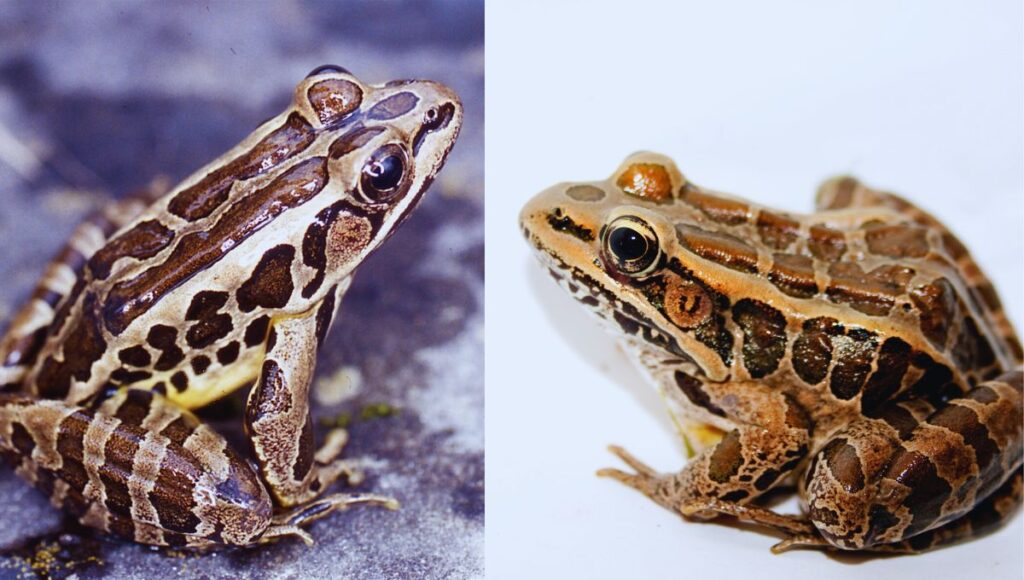
Table of Contents
Everything You Need to Know About Pickerel Frogs:
In a Glimpse:
| Common Name | Pickerel Frogs |
| Scientific Name | Lithobates palustris |
| Other Names | Rana palustris |
| Maximum Length | 4.4-8.9 cm |
| Maximum Weight | 12-45 grams |
| Ranges | North America |
| Habitat | Warm and Moist Environment with Water Source |
| Diet | Carnivore |
| IUCN Status | Least Concern |
| Lifespan | 4-5 years |
Geographical Range:
Pickerel frogs are native to North America, especially in Canada and the United States. The frogs are found in Wisconsin, southeast Minnesota, eastern Iowa, Missouri, and Texas on the west to the Louisiana, Mississippi, northern Alabama, Georgia, and South Carolina to the east.
Pickerel frogs are also found in Southern parts of Canada, such in states like Ontario, Quebec, New Brunswick, and Nova Scotia. However, some of their population is also present in Newfoundland and Labrador which is the eastern states of Canada.
Habitat:
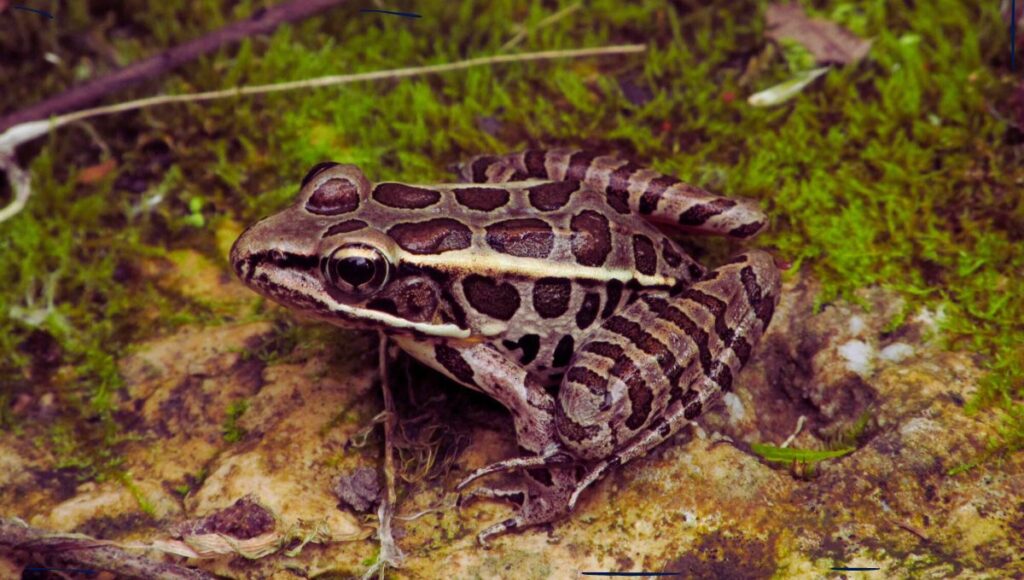
Pickerel frogs have diverse habitats as the northern specimen prefers rocky ravines, bogs, meadow streams, and lakes that are heavily wooded. However, the southern specimen prefers warmer waters in the Coastal Plain and floodplain swamps. They are often found along the edges of streams, lakes, rivers, and even flooded ditches.
Pickerel frogs are most active between April and October and in the winter they hibernate in caves under the silt and debris in their aquatic environments. These frogs are trogloxene species, which means they live in caves but are unable to complete their life cycle there. However, they are most abundant inside the caves during the winter, but they are also inhibited in those same caves during hot summers.
Breeding Habitat:
Pickerel frogs prefer cool, clear water such as temporary as well as permanent and manmade ponds for breeding that are well vegetated.
Physical Descriptions: How do you identify a Pickerel frog?
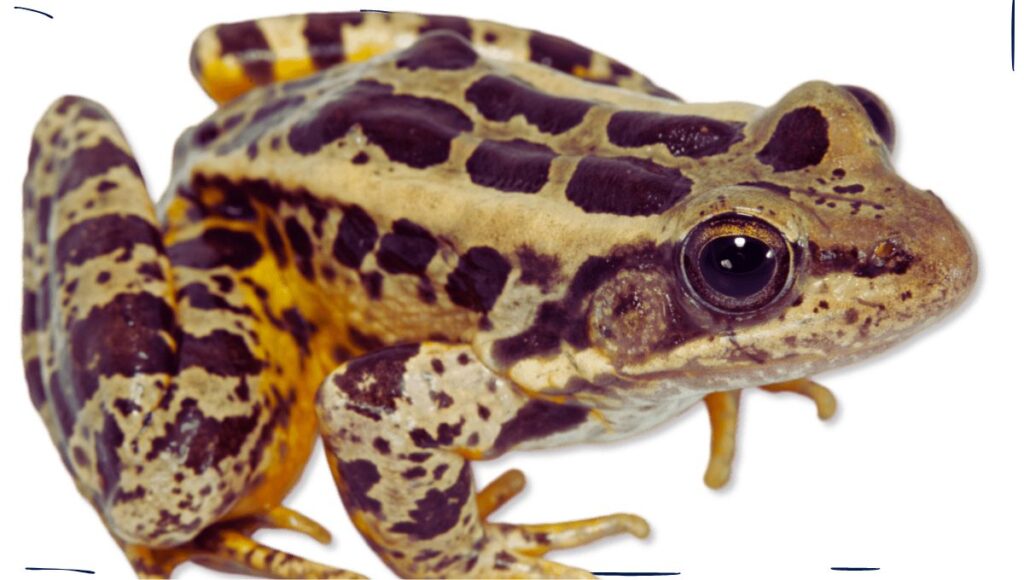
Pickerel frogs are medium-sized frogs with grey and tan colour marked with seven to twenty-one irregular rectangular dark brown spots organized in two columns on their back. These distinctive rectangular spots may blend to form a long rectangle mark on the back. The frogs also have unbroken dorsolateral ridges.
Another distinguishing feature of Pickerel frogs is the orange or yellow flash pattern on the inner surface of the hind legs and you can notice this colouration only after picking up the frog. The front toes are not webbed which allows Pickerel frogs to be fit for terrestrial life.
Measurements:
The snout-to-vent length of Pickerel frogs is 4.4-8.9 cm and sitting height is roughly 2-3.5 cm. The average weight of the frogs is 12-45 grams.
Sexual Dimorphism:
Yes, the North American frogs show sexual dimorphism. The females are bigger and darker than the males. Males are recognized by their swollen thumbs during summer and breeding season.
Defence Mechanism: Are Pickerel Frogs Poisonous?
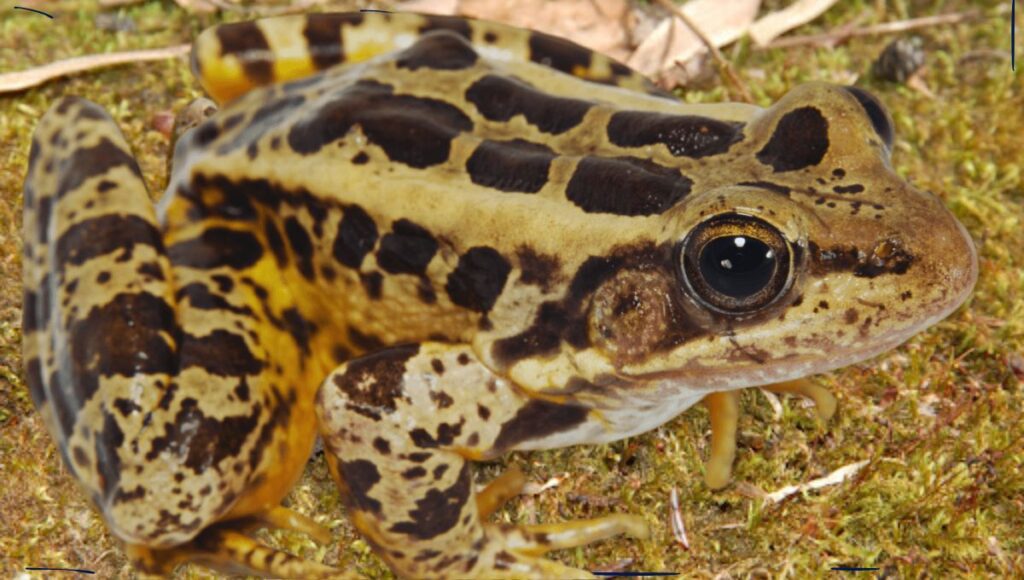
Pickerel frogs are the only native frogs of the United States that are poisonous and have a unique and excellent defence mechanism to avoid predators. The frogs emit skin secretions that are toxic to many predators and also irritating to humans.
Due to the toxic substances, most of the animals in the wild keep a distance from Pickerel frogs. The skin secretion of a stressed and afraid frog is very toxic for other frogs and amphibians and irritates if it comes in contact with the eyes, face, or injured parts of humans.
The tadpoles of this species also exhibit a unique defence mechanism. The tadpoles reduce activity after sensing a fish’s chemical cues and move to stream margins to avoid fish. However, the tadpoles of Pickerel frogs are considered unpalatable to many predators who feed on other tadpoles.
Diet:
Pickerel frogs are strictly carnivorous by nature and to hunt their prey, the frogs often search grassy areas next to a water body. Ants, spiders, bugs, sawflies, beetles, snails, crayfish, isopods, aquatic amphipods, and other invertebrates are their favourite foods.
Predators and Threats:
Most of the predators in the wild avoid Pickerel frogs due to the toxic substances the frog releases but that can’t stop all the predators. Bullfrogs, Green frogs, northern water snakes, eastern ribbon snakes, garter snakes, minks, and prey birds (eg. bald eagles) are their main predators. Many fish also consume their tadpoles. However, when the frogs are threatened, they jump into the water and dive into the bottom to escape from predators like snakes and prey birds.
The frogs also face a few anthropogenic threats, such as urbanization, expansion of agriculture, increasing human settlements in those regions, pollution, and destruction of water bodies that fragmented their habitats in many states in the USA and Canada.
Conservation Status:
Pickerel frogs are listed as “Least Concern” in the IUCN Red List of Threatened Species. Generally, the population of frogs is stable but in some states in the USA and Canada (such as Iowa, Wisconsin, Minnesota, and Ontario) their population is decreasing.
Disease:
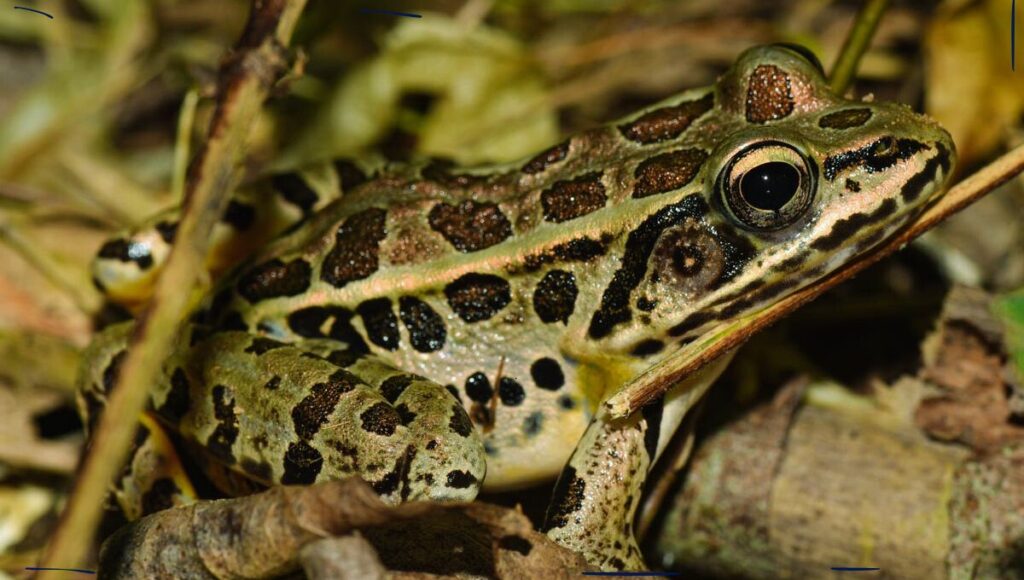
Like other amphibian species, Pickerel frogs are also infected by chytrid fungus ( which causes a massive decline in the population of Mountain Chicken frogs) which results in a deadly skin disease to the amphibians. Apart from that, these frogs are also susceptible to other parasites such as protozoans, flukes, parasitic flatworms, nematodes, and trombiculid mites. Despite the infections, the overall population of the Pickerel frogs is generally stable in the wild.
Lifespan:
Pickerel frogs usually live 4-5 years in the wild. Their lifespan is short because they are infected by fungi and parasites very often. However, in captive care, the frogs can live 9-10 years.
Behaviour:
Pickerel frogs hibernate during the winter (especially November-March) in small caves and come out during the breeding season. The breeding season of the frogs lasts from late March to early May. After the conclusion of their breeding season, the frogs may migrate out into fields and woods where they adopt a completely solitary lifestyle.
Pickerel frogs are usually nocturnal but they are also found in daylight after their mating season ends. These frogs are not usually aggressive but sometimes the male frog shows aggression to other males to defend its territory during breeding season.
Jump and Swim:
Pickerel frogs can swim well despite not having the webbing between their toes. However, the frogs also can jump 2-3 feet or 60-90 cm.
Communication and Calls:
Like any other anuran species, the male Pickerel frogs use calling techniques to attract females during the night of mating seasons and their calling choruses can last up to 5-6 hours. The call of the frog can be described as a short snoring sound, that lasts an average of 2 seconds with a frequency around 1200 Hz.
Apart from mating calls, the males communicate with other males with two other aggressive vocalizations known as “growl” and “Snicker”. These calls are much shorter than the mating calls and can last up to 0.20-1.5 seconds.
Positive Impact on Humans:
Although poisonous, Pickerel frogs have some positive impacts on humans. Like any other anurans, the frogs are insectivorous and consume mosquitoes, larvas, and worms, and hence help in pest control. Additionally, these frogs are also used as fishing bait by humans.
Are Pickerel Frogs Good Pets for Beginners?
Despite being poisonous, Pickerel frogs can be good pets depending on several factors such as experience, personal preferences, and your ability to provide them with their natural environment and lifestyle. However, these frogs are uncommon as pets due to their toxic wild nature.
If you want a Pickerel as a pet, you need to provide it with its specific habitat, diet, and environmental needs that the frog is habituated. Unlike other frogs, these frogs are not resilient pets because they cannot adjust to any other environment. Hence, keeping a Pickerel as a pet is very difficult for a beginner who doesn’t have experience with other frogs.
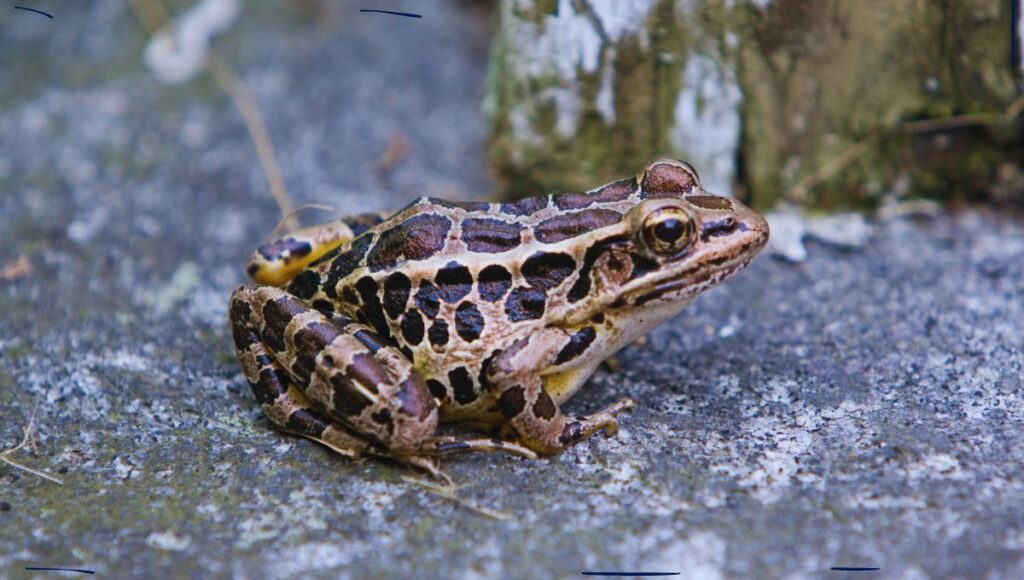
Pickerel frogs are not social animals and they don’t like human touches. Touching them can cause stress to the frogs and as a result, they’ll secrete a toxic substance from their skin which can harm other animals or humans. Also, in a few countries or states, these frogs are not allowed to be kept as pets.
However, Pickerels can be very interesting as a pet if you don’t try to communicate with them and if your main focus is to enjoy their fascinating behaviour, such as hunting prey and soaking in water dishes which are very interesting to watch. These frogs also require low maintenance compared to other pets due to their wild nature if you set up their habitats.
If you are a beginner or hobbyist, it is advised not to keep Pickerels as pets. Still, if you have decided to keep these frogs as pets, be careful of their poisonous nature and avoid kids from touching the frogs. Also, consult with a veterinary surgeon who specializes in amphibians for more details.
How do you buy a Pickerel frog?
These frogs are not easy to find in the pet market. Many illegally captured Pickerel frogs may be found in the market, try to keep a distance from them because fungi and other parasites may infect wild frogs. It is advised to buy these frogs only from reputed breeders and pet sellers. However, before buying them always be aware of the laws in your country about these frogs.
You can also check online platforms to buy pickerel frogs but before buying check reviews, and policies. Also, ask for proof of origin and a health certificate from the seller. Always ensure that your frog is not illegally captured from the wild and that it is born and bred in captivity.
Requirements and Care:
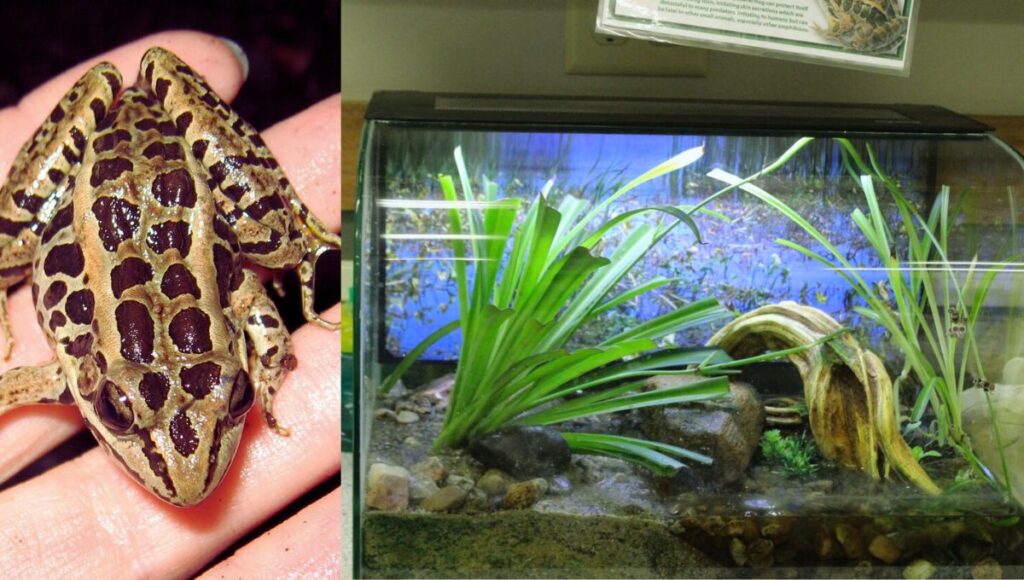
Enclosure:
A 10-gallon tank with a secure lid and proper ventilation will be enough for one Pickerel frog. As these frogs are semi-aquatic animals, the tank should contain 50% land and 50% water, separated by a piece of plastic or Plexiglas placed across the aquarium and sealed with aquarium-grade silicone sealant.
Can you keep two Pickerel frogs in the same tank?
During the breeding season, the male frog often shows aggression to defend its territory and fights with other male frogs. Hence, it is not a good idea to keep two Pickerels in the same tank.
However, you must avoid keeping the Pickerels with other frogs or amphibians in the same tank because the toxic substance that is released from the skin of a Pickerel can harm or kill the other frogs or amphibians.
Substrate:
a combination of soil and peat moss, covered with commercial reptile bark substrate, and sphagnum moss can be used as a substrate for the territorial side which should be at least 2-3 inches deep and will allow these frogs to burrow.
Large and smooth gravel can be used as a substrate on the aquatic side. Gravels should be large enough that the Pickerels cannot swallow and rough gravels may cause skin abrasions and injuries to the frogs.
Temperature and Humidity:
Pickerel frogs require an average temperature of 65-70 degrees Fahrenheit during the daytime and a bit cooler at night. Use a thermometer to monitor the temperature of the enclosure. If the tank is cold, use a heat mat or heat lamp to warm it up but avoid overheating.
These frogs also need a 70-80% humid environment to thrive. You can use a hygrometer to monitor the humidity and also use a fogger and sprinkle water several times a day to provide them with proper humidity.
Lighting:
Professional breeders suggest that 10 hours of the day and 14 hours of darkness is perfect for Pickerel frogs to regulate their daily activities. No special lighting is required but a low-wattage UVA/UVB fluorescent light would be enough to provide them with their necessary vitamin D.
Food and Water:
Pickerel frogs are insectivorous and they feed on insects such as crickets, wax worms, fly larvae, and earthworms. The amount of food required completely depends on their age, sex, appetite level, and health condition. Feed them every other day to prevent obesity and once a week dust their food with calcium and vitamin supplements.
These frogs need stagnant water to breed and survive. You can use dechlorinated water in the enclosure and half of the water will be changed every day.
Handling:
Pickerel frogs don’t like to be handled by humans. They feel stress if you touch them unnecessarily. When these frogs are threatened, they secrete a toxic substance that irritates your eyes, face, and injured parts. Hence, always wear gloves before touching them and wash hands before and after touching the Pickerels.
Cleaning:
Try to change the water daily, and remove waste food and dead insects from the tank to avoid bacterial growths. Once a week deep-clean the tank with a 3% bleach solution and rinse thoroughly with clean water, removing all smell of bleach, dry the tank, and try to add new substrate to prevent bad smells. If the substrate doesn’t smell bad, you can change it every 10-12 weeks.
Pickerel frogs are very prone to be attacked by fungi and other parasites. Hence with proper care, these frogs can live up to 9-10 years in captivity. Consult a veterinary surgeon who specializes in amphibians if you find these frogs are attacked by any fungi or parasites.
FAQs:
Are Pickerel frogs poisonous to dogs or cats?
Yes, Pickerel frogs are poisonous to dogs or cats as the frogs emit very toxic substances from their skin when they are attacked or threatened by dogs or cats. If the dogs or cats come in contact with that toxic substance, it might irritate them, and if they consume Pickerel, the dogs or cats might get sick or get killed, depending on their immunity system and health condition. Generally, dogs and cats avoid consuming these frogs due to their toxic secretion.
Reference: Wikipedia
Also Read: Is American Bullfrog Banned as Pet? 11 Differences with African Bullfrog
Also Read: Are Pixie Frogs (African Bullfrogs) Good Pets? Everything You Should Know Before Purchasing